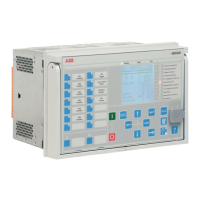reoccurs during the reset time, the operation calculation is made based on the
effects of the period when START was previously active. This is intended to allow an
operating condition to occur in less time to account for the heating effects from the
previous active start period.
When START becomes active, the reset time is based on the following equation.
reset time
START DUR
Cooling time=
⋅
_
100
(Equation 134)
For the IDMT curves, when START is deactivated, the integral value calculated during
START is continuously decremented by a constant that causes its value to become
zero when the reset time elapses during the reset period. If a fault reoccurs, the
integration continues from the current integral value and the start time is adjusted,
as shown in
Figure 351
. The start time becomes the value at the time when the
fault dropped off minus the amount of reset time that occurred. If the reset period
elapses without a fault being detected, the saved values of the start time and
integration are cleared.
Figure 351: An example of a delayed reset in the inverse time characteristics.
When the start becomes active during the reset period, the operate time counter
continues from the level corresponding to the drop-off (reset time = 0.50 · Cooling
time)
Overexcitation IDMT curves 1, 2 and 3
The base equation for the IDMT curves "OvExt IDMT Crv1", "OvExt IDMT Crv2" and
"OvExt IDMT Crv3" is:
t s e
ak b M
c
( ) = ⋅
+ −
60
100
(Equation 135)
1MRS757644 H
Protection functions
620 series
Technical Manual
677

